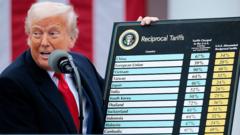In a rising tension between the world's two largest economies, the United States and China have ramped up their tariff dispute, with severe implications for American exporters and global supply chains. The latest developments highlight a 34% price surge on all US goods entering China, exacerbating existing tariffs on US agricultural products and potentially driving them out of the competitive market. Analysts express concerns over the broader repercussions on the international economy as both nations refuse to compromise, signaling a fraught path ahead for trade relations. The distinct lack of willingness for dialogue raises alarms, hinting at increasingly complex trading dynamics with nations beyond the US.
Tariff Tensions Escalate: China and US Dig In Their Heels

Tariff Tensions Escalate: China and US Dig In Their Heels
As trade conflicts reignite, both China and the US remain steadfast in their tariff stances, impacting global markets.
The article text:
The trade standoff between China and the United States has taken a dramatic turn, with both countries relentlessly maintaining their positions on tariffs. Recent moves have severely impacted American firms aiming to penetrate the expansive Chinese market, resulting in a staggering 34% increase on all US goods entering the nation. This hike follows previously imposed tariffs, particularly gravely affecting US agricultural producers who are already facing 10-15% tariffs on their exports. The cumulative effect is pushing many of them out of the market entirely.
From China’s perspective, the government appears unfazed as it looks to alternative suppliers for chicken, pork, and other agricultural products while hitting at the heart of Trump's support in the Midwest. Analysts are voicing concerns over the disruptions rippling through the global economy due to the interconnected nature of supply chains. The implications of economic setbacks could be devastating for international trade.
With no signs of reconciliation, the timing of Beijing's response to Trump's tariffs—the announcement made late on a Friday at the onset of a public holiday—paints a possibly somber picture. This action could indicate a strategy to downplay the contentious news domestically or signify a surrendering of hopes for a hasty settlement, thus complicating the reconciliation process more than previously anticipated.
President Xi Jinping’s lack of reaction stands out; as the Trump administration's latest tariffs were unveiled, he was occupied with tree planting alongside Politburo officials. This response sends a strong message of resilience, indicating a nonchalant dismissal of US threats. The absence of retreat in rhetoric suggests that while a deal remains a possibility, tensions are intensifying.
Additionally, China may pivot towards enhancing trade networks with other countries, including former US allies, resulting in a strategic exclusion of American businesses from emerging markets. This shift would disadvantage not only US sectors but also consumers facing escalating prices driven by tariffs.
Ultimately, as the tit-for-tat tariff measures continue, the horizon looks increasingly bleak for possible resolutions, raising important questions about the future landscape of global commerce.
The trade standoff between China and the United States has taken a dramatic turn, with both countries relentlessly maintaining their positions on tariffs. Recent moves have severely impacted American firms aiming to penetrate the expansive Chinese market, resulting in a staggering 34% increase on all US goods entering the nation. This hike follows previously imposed tariffs, particularly gravely affecting US agricultural producers who are already facing 10-15% tariffs on their exports. The cumulative effect is pushing many of them out of the market entirely.
From China’s perspective, the government appears unfazed as it looks to alternative suppliers for chicken, pork, and other agricultural products while hitting at the heart of Trump's support in the Midwest. Analysts are voicing concerns over the disruptions rippling through the global economy due to the interconnected nature of supply chains. The implications of economic setbacks could be devastating for international trade.
With no signs of reconciliation, the timing of Beijing's response to Trump's tariffs—the announcement made late on a Friday at the onset of a public holiday—paints a possibly somber picture. This action could indicate a strategy to downplay the contentious news domestically or signify a surrendering of hopes for a hasty settlement, thus complicating the reconciliation process more than previously anticipated.
President Xi Jinping’s lack of reaction stands out; as the Trump administration's latest tariffs were unveiled, he was occupied with tree planting alongside Politburo officials. This response sends a strong message of resilience, indicating a nonchalant dismissal of US threats. The absence of retreat in rhetoric suggests that while a deal remains a possibility, tensions are intensifying.
Additionally, China may pivot towards enhancing trade networks with other countries, including former US allies, resulting in a strategic exclusion of American businesses from emerging markets. This shift would disadvantage not only US sectors but also consumers facing escalating prices driven by tariffs.
Ultimately, as the tit-for-tat tariff measures continue, the horizon looks increasingly bleak for possible resolutions, raising important questions about the future landscape of global commerce.





















